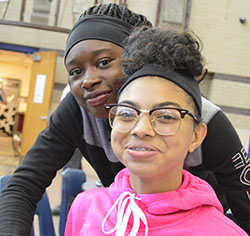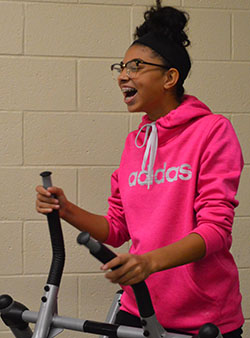Editor’s note: This is the first installment of a two-part series on the challenges of middle school and what local districts are doing to meet them. Read more: Nurturing the In-between Years: It’s All About Relationships
Seventh-grader Cydney Hansma is a girl in constant motion. At her desk, she rhythmically taps her feet and pencil, and rocks her chair back on two legs. In the hallway, she walks fast from one class to the other, often stopping to hug a friend or have a quick conversation. She does impromptu mini dances, with other students joining in. She has lots of friends, who call her “pretty,” “funny” and “goofy.”
On a Friday earlier this semester, the 12-year-old Kelloggsville Middle School student, who wears glasses and braces, has a big bun piled atop her head. It bops along as she does. Most strikingly, her laugh is big and infectious and bordered by a dimpled smile.
Cydney isn’t an academic superstar. She gets A’s, B’s and C’s. She likes math and language arts, but isn’t a big fan of social studies. She plays volleyball and basketball, and likes to read and post videos using her iPhone.
Not giving middle school its due attention can have major repercussions. It’s when many students veer off course, which can change the entire educational outcome.
Cydney shrugs when asked what it’s like to be in middle school: “It’s OK. It’s not all that,” she said. Friends are a big priority, she said, but there’s also a lot of drama, especially in the social media realm. More than in any generation before her, technology is a part of her and her friends’ lives.
She wants to be a fashion model or professional volleyball player, and hasn’t thought much about going to college. “I find some classes interesting and some boring,” she said.

Crucial Years, Fewer Dollars
Kindergarten readiness. Third-grade reading. High school graduation rates. When it comes to the national discourse surrounding education, there’s something missing, local administrators say, and it lies smack dab in the middle with Cydney and her peers.
True to the middle-child syndrome, the middle school years are often given lesser priority than lower or higher grade levels, say administrators. In-between grades generally blend in when it comes to the focus on boosting school achievement.
“You’ve got this spread of time when they come in as elementary school students and are expected to leave as high school students. It does get lost in translation,” said Kelloggsville Middle School Principal Jim Alston.
But not giving middle school its due attention can have major repercussions. It’s when many students veer off course, which can change the entire educational outcome.
“If you look at test scores, you see them rising or stagnant in the elementary, and in fifth grade they start to drop,” said David Britten, Godfrey-Lee Public Schools Superintendent.
Though data shows the decline in scores, funding isn’t necessarily addressing it, Britten added: “The middle school, per student, is literally shortchanged, sometimes severely.”
In Kent County, per-pupil classroom expenditures for middle school students are lower than for elementary and high school students. According to data from the Michigan Department of Education financial information database, for the 2014-2015 school year, per-pupil classroom expenditures including teacher salaries, supplies and other costs were hundreds of dollars less than what is spent at the high school and elementary level.
Caledonia Public Schools was the only Kent County district where per-pupil funding for middle school exceeded high school: $1,131 to $1,121. Interestingly, Caledonia is implementing system-wide programs focused on reading and behavior and the interrelation between the two, including an early warning system that predicts potential dropouts by as young as sixth grade.
Needed: Patience Dealing with Peculiarities
There’s little argument that middle schoolers can be a tough crowd. Students face changes they haven’t necessarily learned how to deal with. Plus they have a new level of self-consciousness and are often highly influenced by their peers.
“They are worried about what people think and what comes out of their mouth,” Britten said. “They are worried about what their peers are thinking so they tend to do things they have more control of, like clown around, be a wise guy, a smart aleck, or tease somebody.”
Spend a half day at a middle school and a few things are evident.
Students like to move, but sit them at a desk and they plop their heads down, jutting their elbows out. They love to socialize, passing around favorite treats, and friendships are of utmost importance. They answer questions in class, but don’t always raise their hands first. The height difference between the shortest and tallest students is more than a foot. Also, there are lots of ways to goof around.
“You’ve got to be a unique person with a lot of patience, and you’ve got to really like that age group and the peculiarities that come with it or you’re not going to do well as a middle school teacher,” said Britten, a former Lee Middle-High School principal.
The age span of 10 to 15 years old is when people experience more rapid physical, social, cognitive and emotional changes than any time of their lives except for birth to age 2, said April Tibbles, chief communications officer for the Association of Middle Level Education, in Ohio.
“What matters is that educators understand the developmental, social-emotional, and academic needs of (middle schoolers), and that school and classroom practices are respectful of those needs, wherever these students are,” Tibbles said.
They also need encouragement, though they may not show it. “They increasingly welcome and benefit from positive relationships with adults outside the home, including coaches, teachers, neighbors, spiritual leaders,” Tibbles said. “They also have a strong need to be part of a group and feel like they belong.”

Collaboration, Time for Socialization
Before school budgets took hits over nearly a decade of cuts, local middle schools were better able to meet the specific needs to the 11- to-13-year-old crowd, Britten said. Common practice was for teams of four teachers to work together with about 100 students, often with a counselor and social worker. Such collaboration allowed teaching to cross subjects, but it took a lot of time. Team and individual planning periods were necessary each day.
“The team itself would focus on individual student development issues and concerns,” Britten said. “They developed plans and activities that were really focused on that age level.”
But the model was expensive and required too much manpower when districts faced ongoing budget shortfalls and reduced staff. “We started to eliminate the middle school concept,” Britten said, noting that the trend occurred during tight financial times including the recession beginning in 2008. “Most middle schools now are middle school in name only.”
Another piece of middle school instruction was time set aside daily for discussion on issues like bullying, hygiene and peer influences. Those periods of time have largely fallen by the wayside to make room for more content and test preparation.
The problem isn’t just funding, Britten said. Middle schools could better reach students, who tend to fluctuate between very active and exhausted. He spent a day shadowing a seventh-grader last year for firsthand insight.
“It’s painful. It’s hard to sit in those desks. It’s hard to not move around. It’s very hard to be a student. They are very much lethargic and asleep at 8 o’clock in the morning.”
Tibbles agreed, saying middle school students prefer active learning experiences over passive learning. “They also learn best when given opportunities to interact with peers. They thrive when given the chance to connect what they’re learning with real-life situations, such as community service projects.”
As Lee Middle-High School principal, Britten used to schedule “snack and yak” time for 20 minutes in the morning every day. “By the time they get to seventh and eighth grade, you have to provide them with time to be social,” he said. “If you don’t, then they will combust.”
Back at Kelloggsville Middle School with Cydney Hansma, it’s lunchtime. Cydney and her friends pass around bags of Hot Cheetos and Takis before grabbing hot lunch. They talk about food, friends and music. They joke and laugh — a normal group of middle schoolers on a Friday afternoon.
CONNECT









